
I briefly mentioned my distaste for “Edible Estates” in a previous post and I figured I’d expand a bit on why that “project” annoys me. I don’t dislike the concept, quite the contrary: everyone in this city should stop watering their wasteful lawns and plant some food instead, for the good of the environment and for gustatory pleasures. But the amount of press and coverage for what ultimately amounts to just an activist art project is unmerited, especially when the garden proposal Haeg makes is a reality for many working class families in Los Angeles. Since he was living in Mt. Washington when he did this project he should have been aware of the gardening practices right around NELA, he ought to take a stroll down the hill once in awhile just to see how the flatlanders live. I took the following pics of front yard gardens in Lincoln Heights mostly in one day, just riding around randomly on my bike. They’re everywhere.
The LA Times recently did a story on a place called Skyfarm (in Lincoln Heights no less) about a middle class family building a “country escape” in the urban environment, meaning they grow food and have some chickens. Oh wow, how unique. Here’s what I read as the subtext: when poor people grow food and raise chickens in the city, they’re just poor and desperate, and that lack of intent gets them no carbon credits. When middle class (often white) folks do the same thing, it’s an exploration in sustainable living and a return to homesteading. This should be no surprise to Eastsiders, as we’ve learned how things work when you’re outside of the media loop: your shit don’t matter ’til they say it does.
Though (and because) they may be off the radar of those that dictate the social gaze, I present you with pictures of green living done on the cheap! Lack of theory does not negate the practice! Be an urban pioneer and click ahead for the tour! (Warning: lots of pictures ahead. I highly recommend you read this on company time.)
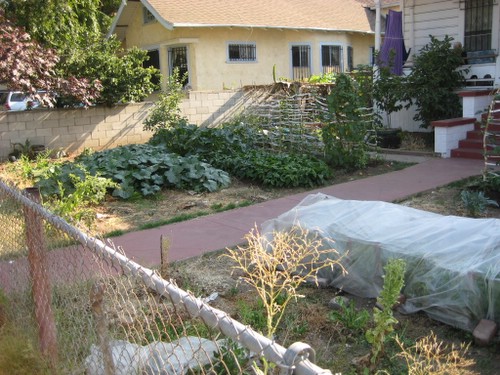
If I remember correctly, the family that Haeg got to turn their lawn into a vegetable garden only did it for one year. In my neighborhood, the practice is not some social experiment, but a part of daily life.

An increasingly rare Mexican vegetable garden. As the acculturation takes over, the sustainable practices give way to the logic of the modern world. “Why grow when I can just buy?” Bananas, corn, tomatoes and some other goodies.
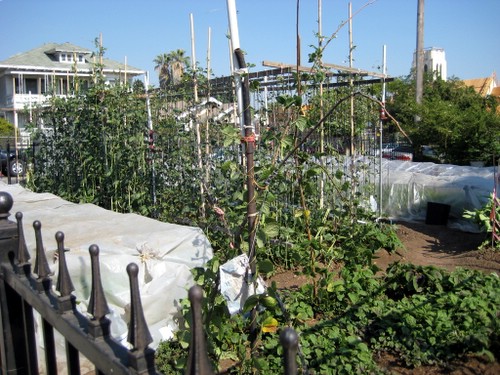
This front yard on Griffin is one of the most productive around: they constantly have crops in rotation and in different cycles of growth. Plastic sheets = hothouse.
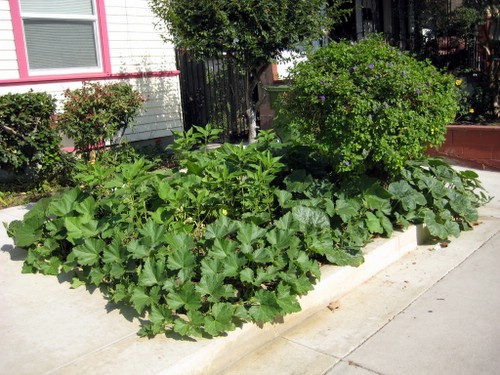
Some sort of squash vine growing near the sidewalk.
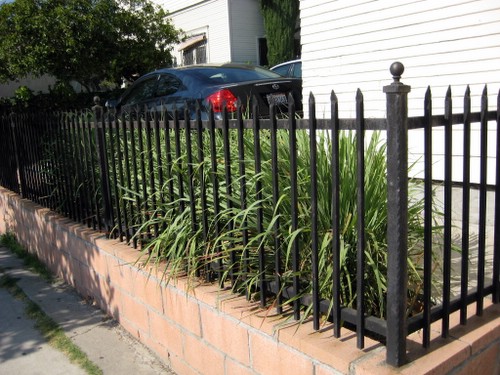
A whole bunch of lemongrass! It looks pretty and it’s convenient when you’re making a Thai style soup. Easy to grow and much cheaper than buying at the market.
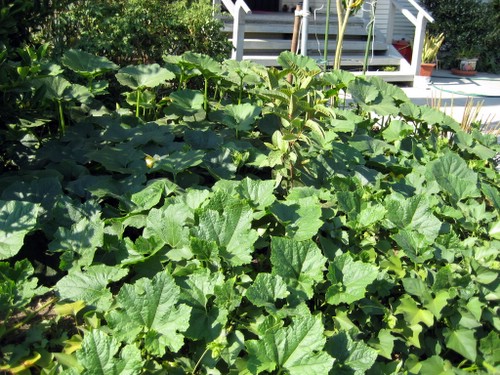
More squash vines.
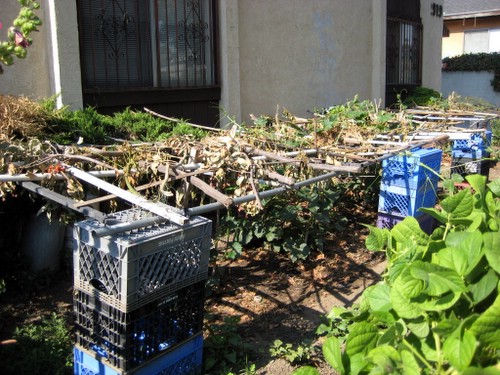
One of my favorite aspects of these gardens is the reuse of existing materials for trellises, in this case milk crates, pipes, and tree branches. Only an earth hater would go out and buy specifically designed trellises.

Green beans growing on and over the fence. No matter what the people at FallenFruit.org tell you, it’s not cool to pick your neighbors hard grown veggies and fruit without asking. Neighborly understanding trumps legal rights.
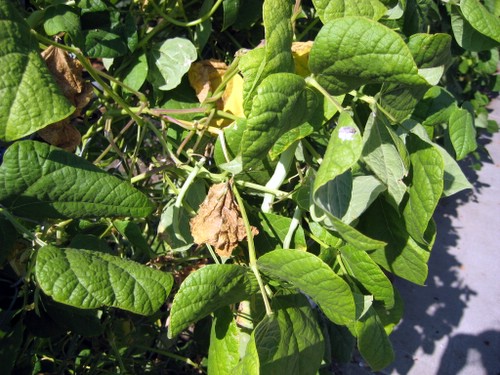
Look at them green beans grow! Cooked in a little bit of oil and garlic, it’ll beat most any restaurant dish on freshness alone.
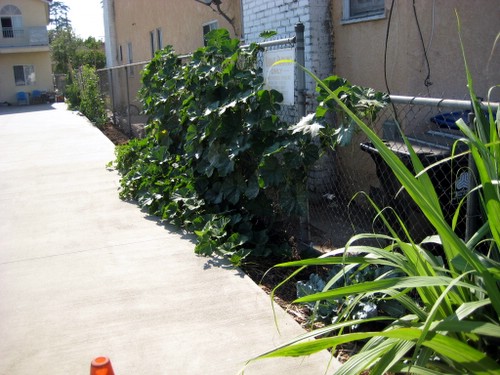
Even with just a little patch of dirt you can grow a few worthwhile items to eat.

Another great looking trellis made from fabric, old hoses, wood, and string. Notice how this attempts to bring plants back despite the concrete.

It’s hard to tell from this pic but there are a few items growing in this minimal island of dirt in a sea of cement. My theory is that the newcomers still appreciate the earth and it’s bounty, while the Americanized 1st generation just wants parking for the new car. This happens with Latinos and Asians alike.

If I was a kid I think I would love to play underneath all this growth.

No dirt, no problem! Just put some in a bucket and we are back in business.

A good use for recycling bins!
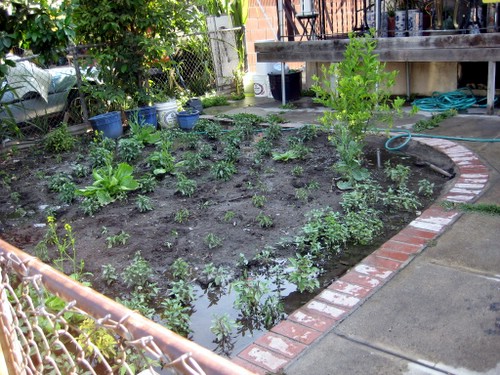
A freshly watered patch of budding plants.
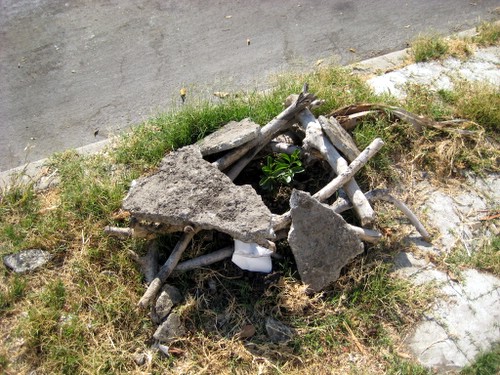
I love seeing these sort of examples of plant TLC, especially when it includes found sticks and slabs of concrete. Though it’s still vulnerable to asshole dogs and bored kids, this collection of items is usually enough to signify someone-is-caring-for-this and respect will be given to said plant, even if on a public sidewalk.

This pic I sneaked thru a fortified fence, even though it was mostly a cement terrain for sporty cars, some senior must have demanded a bit of space for greenery.
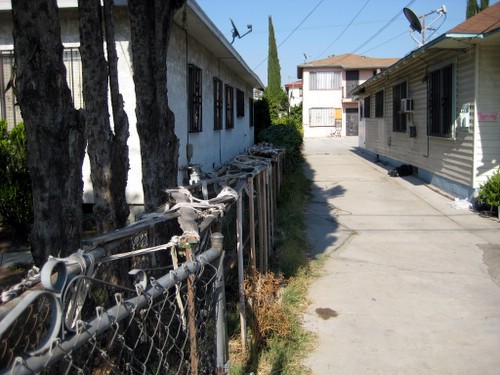
Another DIY trellis, though the plants were still small.

I have to hand it to the Asian families in Lincoln Heights, their gardens are the best around. The Mexican ones are paltry by comparison, almost as if they were merely a nod to tradition rather than an actual implementation of tradition. I know that Americanized Mexicans get all weird and uncomfortable at the suggestion of their agricultural roots, somehow thinking their new Mall Harvesting Culture can replace that corn growing past. Trust me, you’re still Beaners, might as well grow your own beans. Above we see a small Mexican garden unafraid of what the neighbors think.

Blue tarp, red fabric, white string: it’s an intentionally patriotic garden. Who are you to say otherwise?

They also had shoes and t-shirts absorbing the natural energy of the sun to reduce the dampness of just washed clothing, because electric and gas dryers are also just for earth haters.

Even better was how the garden extended into the alley, on a barely visible lane of dirt. In a few months, when the food price crisis actually starts affecting us, this will be a valuable feature of a new rental, a spot to grow your own food.
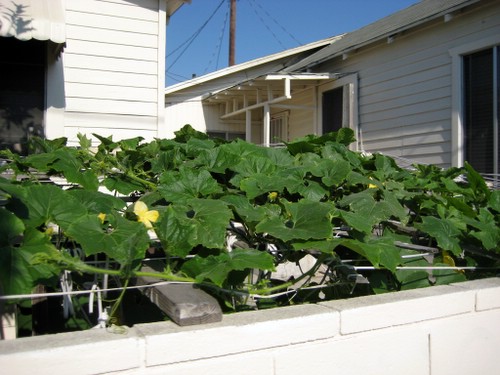
Above the cinder block wall a splash of green indicates the cultivation of fresh veggies.
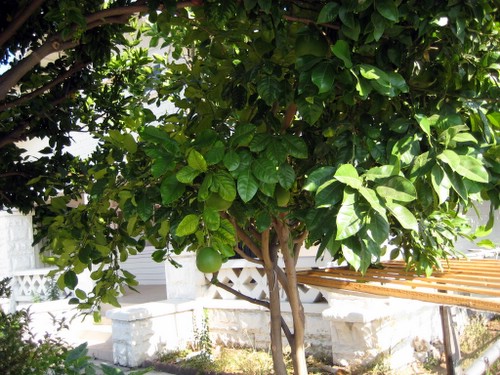
It’s not just veggies though, lots of fruit trees show up in front yards as well. Here we have a pummelo.

This guy was clearing out space for a vegetable garden.
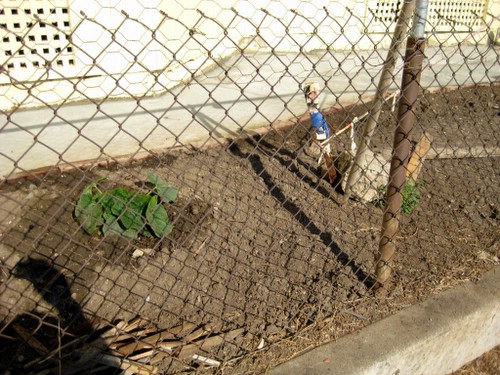
And he already put in a squash plant.

Err, let’s take a slight detour. Even if you don’t grow veggies, something like this rock and figurine garden will undoubtedly be better in the long run than just some grass. Plus you have instant ammo for slingshot wars.
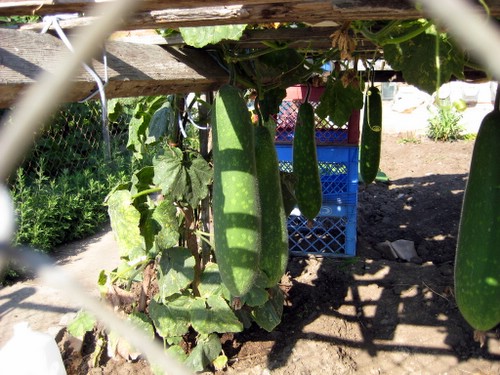
Some sort of bitter melons growing in a productive garden. Where’s the LA Times reporters to cover this bounty?

Yum, Thai Basil!

An orange tree next to a cool cactus.
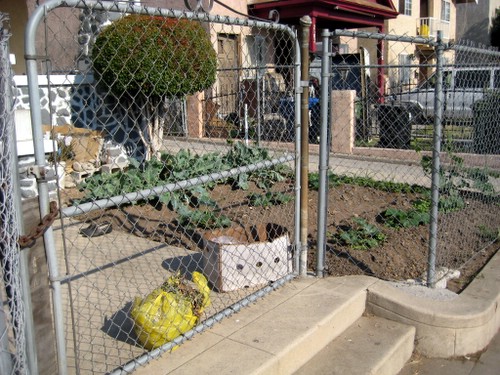
This house is always in veggie production mode. The little bit of grass they used to have is now gone as well.

Maize and tomatoes planted together.
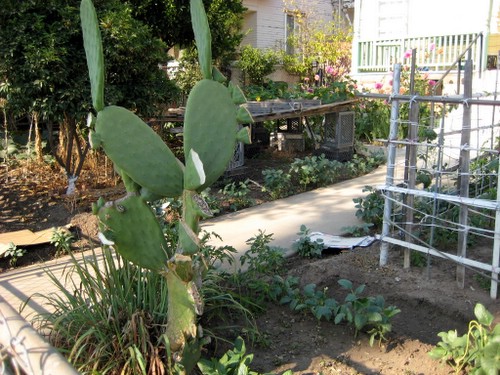
In a garden with some decent crops, a bad example of how to pick nopales. I don’t know how the myth that “it’s better to cut nopales half-way” got started, because it’s just not true. That just makes the plant have to develop unnecessary scar tissue, break the paddles off at the base.
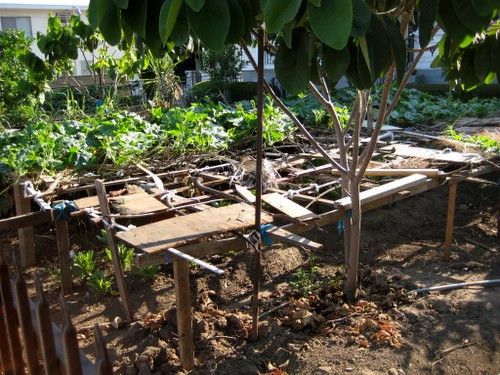
Another great example of trellis work.
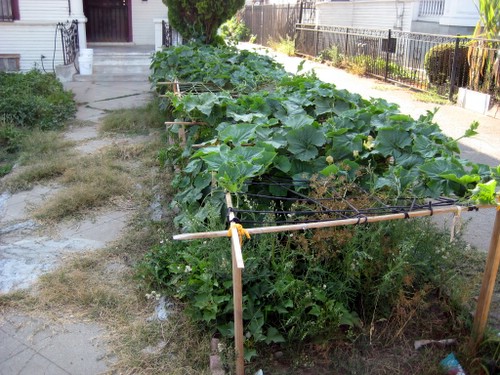
I like how this place tends to the food and can’t be bothered with the grass growing thru the walkway cracks! You gotta have priorities.
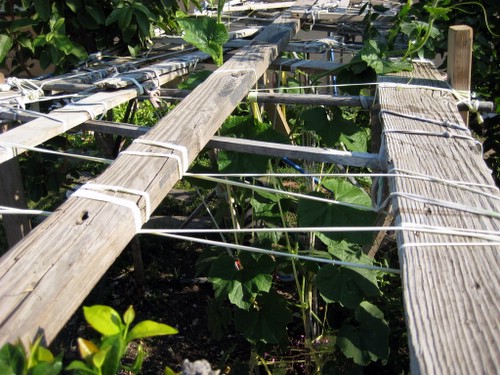
Yet another front yard veggie garden, with some solid structures for the creeping vines. I wish I could peer into the backyards of these homes as I bet they have lots of good stuff there as well.
Look closely and you’ll see a granada starting to turn red. Considering how expensive they are at stores, this is a great idea for a fruit to grow. That and avocados of course.
Next to the pomegranate tree, a bunch of nopales with some tender nopalitos ready for the harvesting. I know this guy picks his paddles properly, thus the abundance of new growth.
A fruit tree peeking over a wall.
Tunas!
Uhh, not much veggies here but I think the Virgen is telling the ducks and frogs to help fertilize the neighboring gardens and to eat only the pest bugs. I prefer to see stuff like this instead of just the same old thoughtless lawns.
Well that’s it for the lil’ tour, hope some of you are inspired to grow something other than just grass. And I hope some reporters start looking at actual practices of earth friendly people of other economic brackets rather than covering a friend of a friend that’s dabbling in “sustainable living” as a hobby.

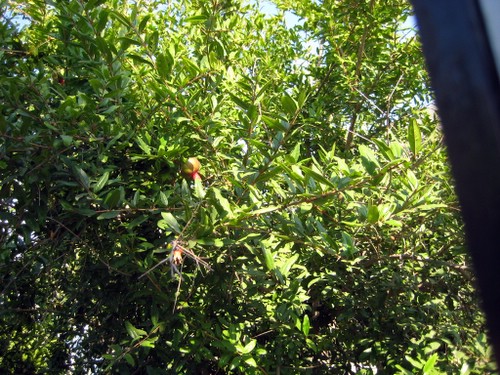



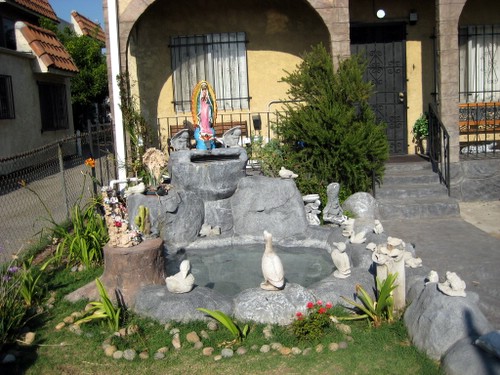
A beautiful report! Shows we all can and should do it too. Don’t look for any of these yards in the HOME section of the Times!
Thanks for doing this. You know, I am all about the urban gardens. Those are really cool pictures. Dang the way things are going with our economy—these types of gardens may be a matter of necessity in the near future. I love the recycled sticks and broken cement too. I made a walk-way with broken cement that my neighbors left on their parkway. I DID ask for permission to take it too. I am growing oregano, basil and chilis on my porch.
Another great idea for conserving water is to plant a cactus garden. They are low maintenance and so beautiful too.
El Jardin on Bridge Street in Boyle Heights has a last Sunday of the month market with gardening tips, music, a fonda (garden food counter), and greening inspiration. Also, maybe this is old news—but check out this 6 minute film called “Recycle” about a Mexicano that has a cool urban garden in Echo Park—all from recycled dumpster diving found objects. Here’s the link http://blip.tv/file/852974
This was giving me flashbacks of the South Central Farm.
If anyone needs fertilizer, there’s a supply on San Gabriel Blvd at the horse stables north of the Montebello Town Center. I suspect the donor, Jim, may have gotten some grief about the way he had the stuff piled up, and, now it’s in a container, but it still says “free fertilizer”.
I think you’re supposed to compost it first, so it breaks down some more. Due to its urine content, it’s more “green” than “brown”, but it cooks up in the pile pretty well.
when i go walking down pasadena and griffin, i look at these gardens, and i’m reminded of my mother’s garden in the backyard of her suburban home. it wasn’t because she was trying to reconnect with her farmer roots, it was more because the herbs that are so necessary in vietnamese food were inaccessible or expensive. i look of those gardens, and dream of when i can have my own home with land so i can grow my own food.
The first thing I liked about this side of town were the productive gardens the Chinese-Vietnamese gardens tended by everyones stay-at home grandma or mom.
One thing a friend of mine brings up about these tiny victory gardens is the maintenance of soil quality. She said that after a few seasons, the quality of vegetables starts to fall off pretty quickly if the soil is not kept healthy and chemically balanced. Then she went into a lot of detail that made my eyes glaze over.
There is a lot to these mini gardening plots, and it isn’t just a mexican or chinese thing. There are plenty of po’ white folks all over this massive ass nation who have been tending gardens for generations (having a small slice of my heritage coming from that stock, I can attest to this with old pix).
Articles in the Times about rich people doing this are just signs of where our culture is heading – more people growing their own food again. The rich folks will likely keep their gardeners on, but they’ll instead be growing crops to demonstrate the rich person’s connection to “slow food” and locally grown whatever whatever.
This is great. I was reading the Arroyo Monthly and they had an article about Haeg the Edible Estates guy and I was like in my head, because I’ve gone to quite a bit of his stuff, “Why is this groundbreaking?” It’s so weird though, if a upper middle class guy with a fancy degree has a garden in his front yard he’s ground breaking, anybody else does it they are hicks.
But lets not play this it’s only about class game, because it’s not. It’s about race too and as I said we didn’t make that way, so people who get their panties in a bunch about that kind of thing being brought up should really get over it.
The people of NELA should start applying for some grants so they can get book deals and speaking engagements at Farmlab.
Browne
I know the folks who were in the Times. He’s a self-employed photographer and actor, she’s a stay at home mom, bee- and chicken-keeper. They’ve lived in Lincoln Heights for something like ten years, they don’t have a gardener, and I’d like to respectfully suggest that the snark about them is misguided.
In my Lincoln Heights neighborhood I’ve watched how good ideas spread like wildflowers (hehe). If you do something cool or interesting in your yard, it will inspire the neighbors to do something similar. I’ve had front yard gardens for the past 15 years or so and not only do they provide me with fresh veggies, it also gives me the chance to meet neighbors and talk to passer-bys (some more friendly than others). I get a lot of neighborhood chisme this way. No need for celebrity gossip rags for me, just tell me what the lady down the street is up to! Anyways, now a few of my Mexican neighbors are warming up to the idea of growing their own food again and keep asking me for soil and “extra” fertilizer. If it gets them to start growing something else besides roses, I’m willing to share. The Chinese neighbors just sort of watch me and peer over the fence, looking bemused by my gardening techniques.
@Kim – I think the main complaint is against the Times, which highlights the yuppie spa-hippies, and ignores, um, “our parents”, if you know what I mean. Now that we’re all old and know how to pretend to be white, we can look back and see how jacked up and unfair the system was to our ancestors. And then, we see these immigrants here, behaving a lot like our recent ancestors, growing food for cultural and fiscal reaons, trying to make their way in this foreign country, and seeing that they’re getting no respect.
Grrrrrr.
So we’re just venting a little bit, that’s all. Even ubrayj. (it’s a tightrope trick to be white and trashy in LA. usually, you have to live in some immigrant neighborhood just to feel normal.)
If you think about it, most of us here on this blog are as much, or more, like those Skyfarm spa-hippies than we are like the immigrants. We just lack flowing cotton and linen pants and dresses, and shirts from Guatemala. That and money.
We’re like Michelle or Barack Obama getting pissed off at Chelsea Clinton for managing a hedge fund. (Not that they have, but, suppose they did.) It’s our job to “represent”!
@alienation- Thanks for explaining. I get your point, but there’s also a difference between getting no respect, and getting no press attention in a flayling local newspaper that lacks the resources to cover stuff that isn’t handed to it via PR or word-of-mouth in the circles its reporters swim in.
I marvel at our neighborhood gardens, and don’t know anyone who doesn’t. A blog like this one is the perfect outlet for a respectful, informative survey on what’s going on in the fertile lawns of LH. Now don’t be surprised if you see a story on them in the Times at some point, because reporters do look to blogs for inspiration!
I think inspiration from someone else’s writing is called stealiing.
“I think the main complaint is against the Times, which highlights the yuppie spa-hippies, and ignores, um, “our parents ” Alienation.
That’s my main beef with the Times. It’s not a community paper. It’s not a weekly. It paints itself as a national paper and the best coverage they can give people of color is that we kill each other.
They are supposed to cover everyone. That’s their job. It says the LA Times. It doesn’t say this is the upper middle class white people Times, if it did then I would expect nothing, but they say they pretend as if they are covering everyone, fairly and they are obviously not.
This impacts my life. This impacts how people see me when I go to NY or Chicago or London and I have to answer questions about gang life and rap music over and over and over again.
It’s fine to talk about gang life and the killings going on in various sections of our city, BUT in the feature section of that paper, the reporters are freakin’ lazy. They won’t try to go out to find out anything about anyone, but their circle jerk of friends. No random stories about Latinos or Asians or blacks just about them and no stories about what we do with no “racial” or “great that they’ve come so far” bs slant.
I mean really how do you manage to be in LA and have only friends that look like you. That’s not just to white people, but people of color too, that’s some real groundbreaking stuff right there. That you don’t have one random person that is outside of your ethnic group to write about. No one sends you a press release on a person who isn’t white? Who are these PR companies, possibly I should write some press releases and send them to lazy reporters.
But why is that? Why can’t someone find a story outside of the press releases, why can’t people leave their neighborhood. I mean for godsakes their job is to write about people, meet some new damn people and if you do find someone cool writing stuff online don’t co-op the freakin story. If your ass doesn’t know how about given it to someone who does.
___
Excuse my spelling of stealing. I should never respond via born in the 80s technology devices. I hate typing on phones, I was born in the 70s. I’m 30. I capitalize the letter “I”.
Browne
Great post Chavo!
I am also fond of using aspects of existing materials, my parents seemed to do that quite often, and my dad even built a corral type of wall using pieces of cement from the old drive-way.
As for growing our own food we never really had full blown gardens like the ones you documented, but at one point we had calabasas, onions and tomatoes so far the tomatoes are the only ones that lasted.
we do got a few matas chili Serrano but mostly we have lots of plants and foliage including lots of fruit tree that consist of limes,pomegranates,avocados,plums and of course ypu can’t forget the savlia and nopales.
For this past mother’s day I decided to create a new garden for her. I chose an area in the back of the house near the laundry room that had been neglected and overgrown with weeds and trash. I cleaned it up and potted new plants in old buckets and pots that I painted with bright colors.
I also set up a mini lounge area for her, what I did was I painted those old white plastic patio chairs with bright green colors. I found a cheap table at Big Lots and set that up as well. I really came out nice and fwd a few months the flowers and plants set in nice but it does take care and maintence. She enjoyed this more then any other gift that she gotten in the past.
There are also many community gardens around the city I am guessing for people who do not have a yard. Is seen some around for years and years. Does anybody know how those places work? Is it just city land they rent out?
That’s a lot of gardens!
My family never grew anything besides fruit (figs, aguacate, mulberries, oranges, lemons, apples), almonds, nopales and some chiles. It’s a shame too because my grandpa was a jardinero so he knows about working the land. (My father doesn’t do anything gardening, he’s not allowed.)
Our mora tree provides nice shade to keep the front rooms of the house cooler. There’s also nothing like laying in the hammock of our mora tree on a lazy summer afternoon. It’s much cooler than being inside with a fan blowing around hot air (no a/c!).
My mom and grandma also use some of our plants for healing purposes, e.g., ruda for earaches, té de siete azahares for cramps, and sávila for sunburns.
These pictures bring back memories of my parents tearing out the front lawn and plants fruit trees and flowers and vegetables. Ah, the wisdom of our ancestors–they didn’t need no stinkin’ college degree to tell them that living close to the land was the best way to live.
What a great post! I enjoyed the photos. My folks used to grow food too. The first thing I noticed when I moved into my apartment was that the neighbors across the sidewalk have a whole bunch of corn growing in their flower bed. It was heart-warming. Clearly I’d been away from the brown folks (for school) for much too long!
Thank you for doing this post! My family grows peaches, misperos, guayabas, nopales, chiles, limones, yerbabuena, savila…My dad loves growing things and is always secando seeds and growing seedlings…we always joke that all of our food from our yard is “organic”, I tell him he should go to the farmer’s market and sell it to white people for an extraordinarily high price, lol….”organic”, “local”, and “handpicked”, I mean come on!
thanks for your thoughts on the edible estates project, and i couldn’t agree more.
what is considered radical among most middle and upper class suburban americans (and apparently the press) is just common sense to many other urban residents, including many recent immigrants (who tend to have a more sophisticated and thoughtful relationship to their food and land). of course there is nothing original about the project, growing your own food is one of the most fundamental human activities….which makes the amount of press it has received rather ridiculous. i agree that it is a bit absurd that planting a few lawns with food is now a news story! the intention of the project is to reveal some truths about the way we are
living today, and for most americans this means a profound disconnection from our food, land and neighbors.
i have planted seven gardens so far, for different types of families in a variety of neighborhoods. this year one was planted for an apartment complex in south austin, one for a family in the city of baltimore, and another recent garden was for council estates in the southwark neighborhood of london. [photos at edibleestates(dot)org]
i welcome any feedback that you might have…and really appreciate those wonderful photos that you took in the neighborhood. great inspiration for us all.
Great post!
When I tell people who don’t live here about the amazing front yard farms of LH they have no idea what I’m talking about. It doesn’t even register for them, it’s just poor people being poor, and the topic will usually turn to someone’s “awesome” new Prius or bamboo floors or some other eco-jerkoff shit. I keep talking about it though and how about a third of the houses on my street hang their clothes out on the line and how if you don’t re-use your old security bars for something in your garden, the metal man will whisk them away for recycling before you can even close your gate and crack open a beer.
Some of my neighbors have made some nasty comment about my front yard and how I let the lawn and stiff looking shrubs die. I just couldn’t live with wasting all that water and energy on mowing that crap. One day it will be a garden, right now it’s dirt. I actually prefer my neighboring front yards as just plain dirt as opposed to these stark lawns with a few rose bushes or the concrete parking pad. Although, one day I hope all the dirt patches (mine included) are growing food.
I agree about not taking other people’s crops without their permission. However, there is an avocado tree in South Pasadena that is so ignored (it’s just soooooo convienient to just go buy them at the Whole Foods on Arroyo, huh?) that there is often avocados rolling all over the street and sidewalk…and they are delicious.
Here’s another side of the conservation coin: (From ABC News)
Celine Dion’s Florida House Guzzles 6.5 Million Gallons Of Water Per Year
Performing for years in the Vegas desert apparently hasn’t taught diva Celine Dion much about water conservation.
Amid a worsening drought that’s sucked Florida dry for the past two years, the pop legend used 6.5 million gallons of water last year at her home on Jupiter Island, Fla., according to a study done by the Palm Beach Post.
That’s nearly 18,000 gallons of water a day, about 100 times more than the 170-gallons-per-day the average resident uses every day, according to the Florida-based U.S. Water Institute. Dion’s annual water usage could fill more than 10 Olympic-sized swimming pools.
And she doesn’t even live there.
A 9,800-square-foot home is under construction at the South Florida address. Dion’s publicist did not return phone calls for comment.
Florida residents and national experts were appalled when Dion’s high water use was reported in the Post.
“It’s outrageous for an individual to be using that much water,” said Wendy Graham, the director of the U.S. Water Institute.
http://abcnews.go.com/Technology/Story?id=4950384&page=1
This morning they had a segment on FOX LA about people growing their own gardens especially in these ruff times with the cost of food etc, but the gardens they feature are in Pacific Palisades? “it’s a rising trend”they say hmmm little do they know or care the gente been doing this for the longest
here is link to video
http://www.myfoxla.com/myfox/pages/Home/Detail;jsessionid=146277B4E6EF729872906686CA7B214A?contentId=7000702&version=2&locale=EN-US&layoutCode=VSTY&pageId=1.1.1&sflg=1
The neverending injustice of the media. sigh…
Some long time ago, in the 70s, in Monterey Park, when there were still a lot of JAs there, it seemed like every JA had a garden in the back. If you saw that someone didn’t have one, there was little comment about it there, but at home it’d come up that so-and-so doesn’t grow anything, and, what a waste of land.
The history of these mini-farms in the back yards goes back, to the postwar years, and to Boyle Heights. I found this article about the Gardener’s Association building on 1st St near Mariachi Plaza.
http://www.discovernikkei.org/forum/en/node/1704
But at least they think out communities are “inspirational,” and that almost make it fair…
It’s like inspiration is the new word for conquer, steal and make it mine.
Browne
^Nice one! There needs to be the Browne Guide to Modern Meanings.
I went to Machine Project (near the Edendale Library, on Alvarado) a couplea years ago when the Edible Estates art project was on exhibit, and I must state that I was surprised that such a formerly ordinary thing was being touted as art. My amazement was that garden comestibles as art was considered innovative as well as that a reintroduction of it was needed.
When I came stateside in the 1970s, my folks immediately set up a garden from which we ate almost daily. That was in Montgomery, AL. (I owe my d.i.y. demeanour to my folks, I might add: they built and raced their own cars semi-professionally, churned their own ice cream, brewed their own wine and root beer and so forth. They were middle class, military and yet consumerism was not so much a part of their life as one might think it was. I took that attitude and went on to create a 15-year “career” in punk rock zine publishing right here in Los Angeles.)
It is indeed a sign of how destitute the L.A. Times has become when it touts something that remains common enough and a quick bit of footwork—cheers to El Chavo for all the easy shots of modest as well as vast and involved gardens—as art.
^I remember your Angry Thoreaun zine. I think I still have a copy somewhere…
wow, after that long parade of photos, it feels like i just(through the wonders of the internet)walked through the garden of eden. i love the efforts to bring a sense of suburbia to lincoln heights but, c’mon, there should be some scheme to all of this.
let’s stick to a universal or standard code of gardening. instead of the random scattering of seeds, there should be an organized vision or plan. maybe it would help to be thoughtful of where seeds should go: jungle plants there, useless greenery over there, marijuana here, flowers somewhere there…
the planting of mulitcellular organisms is a science. let’s get with the program!
HAHA at Rosie, she’s silly. “A standard code of gardening?” That sounds pretty dumb. Maybe you can’t live without your imposed schemes but the rest of the world can get by nicely without them. I hope your “organized vision” for seed scattering works out well in your suburb, keep us updated as to those scientific efforts. Or are you just talking babosadas just because?
im not imposing anything on anyone. i just like to have an opinion. last time i checked you had one too.
el chavo,
by the way i like your post. see, im nice.
visit my opinions at barriowindow.blogspot.com
Last time I checked, everyone has an opinion. So what? I’m glad you like my post but that still doesn’t mean your “standard code of gardening” makes any sense, it still sounds silly. BTW, you might want to link your new site to your name instead of the one that disappeared.
ok. thanks! it’s linked now, i think…
I like your pictures and your article. The gardens are gooood. Does anyone know where i can get a Misepero Tree?
i like this site
Wish I would have come across this much sooner. Beautiful pictures of beautiful gardens. Seeing these gets me even more pumped to finish my little garden.
This is one of my favorite posts. I always feel good when I re-read it.
I’m finally going to be growing stuff in the front, btw. Thanks for the inspiration.